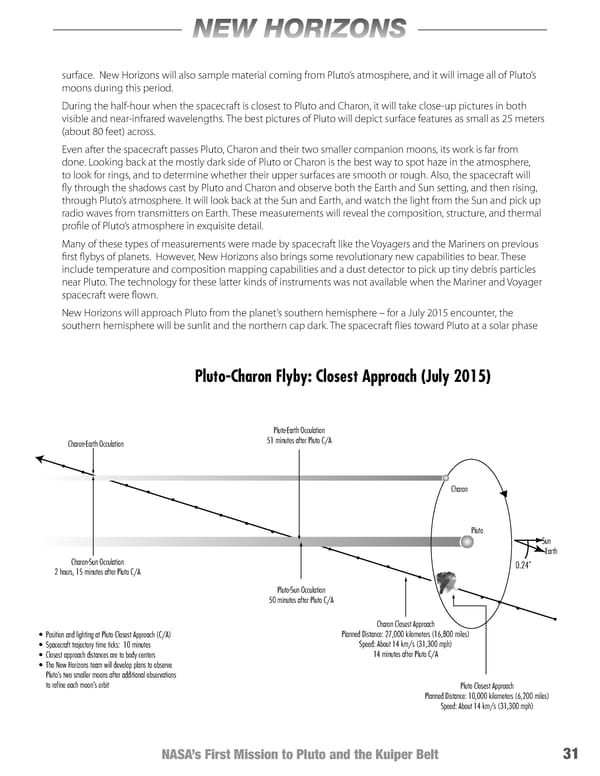NEW HORIZONS surface. New Horizons will also sample material coming from Pluto’s atmosphere, and it will image all of Pluto’s moons during this period. During the half-hour when the spacecraft is closest to Pluto and Charon, it will take close-up pictures in both visible and near-infrared wavelengths. The best pictures of Pluto will depict surface features as small as 25 meters (about 80 feet) across. Even after the spacecraft passes Pluto, Charon and their two smaller companion moons, its work is far from done. Looking back at the mostly dark side of Pluto or Charon is the best way to spot haze in the atmosphere, to look for rings, and to determine whether their upper surfaces are smooth or rough. Also, the spacecraft will fly through the shadows cast by Pluto and Charon and observe both the Earth and Sun setting, and then rising, through Pluto’s atmosphere. It will look back at the Sun and Earth, and watch the light from the Sun and pick up radio waves from transmitters on Earth. These measurements will reveal the composition, structure, and thermal profile of Pluto’s atmosphere in exquisite detail. Many of these types of measurements were made by spacecraft like the Voyagers and the Mariners on previous first flybys of planets. However, New Horizons also brings some revolutionary new capabilities to bear. These include temperature and composition mapping capabilities and a dust detector to pick up tiny debris particles near Pluto. The technology for these latter kinds of instruments was not available when the Mariner and Voyager spacecraft were flown. New Horizons will approach Pluto from the planet’s southern hemisphere – for a July 2015 encounter, the southern hemisphere will be sunlit and the northern cap dark. The spacecraft flies toward Pluto at a solar phase ������������������������������������������������ ���������������������� ����������������������� �������������������������� ������ ����� ��� ������� ��������������������� ����� ����������������������������������� �������������������� �������������������������� ����������������������� �������������������������������������������������������� �������������������������������������������������� ������������������������������������������������ ��������������������������������� ������������������������������������������������� �������������������������� ������������������������������������������������������ ����������������������������������������������������������� ������������������������������� ���������������������� ������������������������������������������������� ��������������������������������� NASA’s First Mission to Pluto and the Kuiper Belt 31
 New Horizons Page 40 Page 42
New Horizons Page 40 Page 42